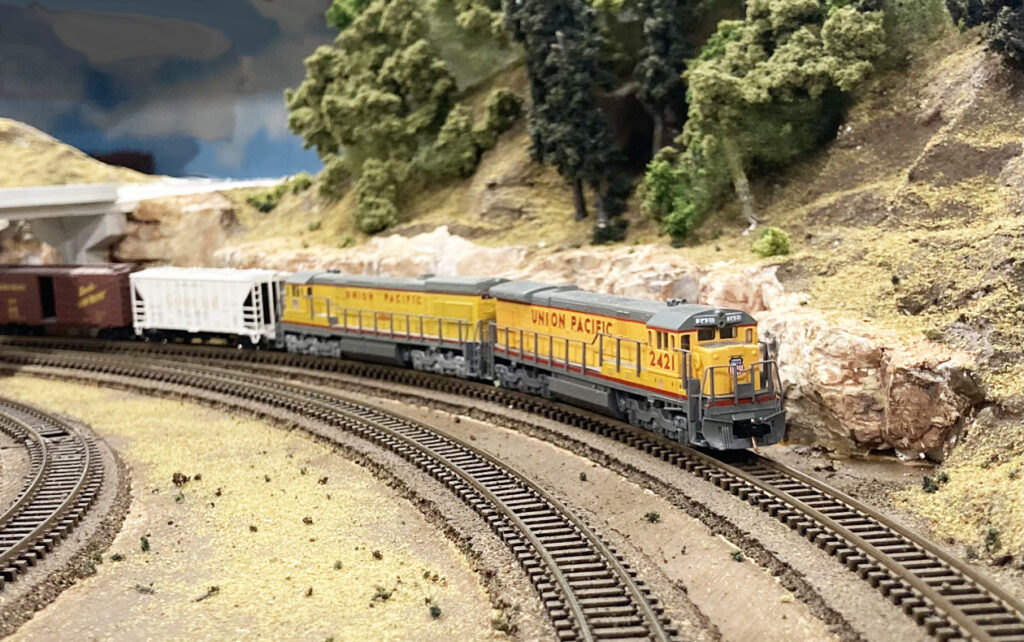All about the community of model railroading and rail enthusiasm
October 21, 2021
If anything good can come of a pandemic, it’s sending model railroaders back to their projects and layout rooms. The Whitehurst & Pine Ridge Railroad has experienced significant growth since early 2020 through evolution of operations, when staying inside seemed like the best idea.
While temptations to acquire more right of way have been tempered, a lot of new things have emerged over the past 19 months. Since our last installment, track has been completed, scenery continues to develop – little bare plywood remains – and refining operations continues.
Some new additions have been chronicled in the Cowcatcher: the development of lower staging (July/August 2020); the Carthage Viaduct (November/December 2020); disguising main lines (March/April 2021) and building The Times-Gazette modern-day newspaper plant (September/October 2021 and November/December 2021).
The biggest development of the railroad has been defining its purpose. What does it do? Why is it there? Where is it going?
The railroad’s operational scope has evolved into streamlined movement of freight from Dallas and Kansas City via Union Pacific and Kansas City Southern with limited main line switching. Call it a preview of Precision Railroading.
Once trains depart from Dallas and Kansas City, the only real switching is picking up and setting out cars at interchanges in Texarkana and Fort Smith. The heavy lifting happens with the W&PRR in Fort Smith and a KCS local in Texarkana, AR.
The only exceptions are UP’s coal drag between the Monticello Mine in Mount Pleasant to the power plant in Dallas and switching Buhrman-Pharr Hardware in Texarkana, TX.
However, the coal job is run by a dedicated UP crew and strictly moves from Mount Pleasant to Dallas Yard, so manifest and unit trains typically roll through. In Dallas, cars are handed off to a yard switcher that serves the power plant. Outbound cars to the mine are picked up on a departure track for the ride back east.

The railroad has a diverse portfolio of commodities anchored by grain and agricultural products, petroleum products and coal. Secondary commodities include cement, produce, beer, paper, scrap, plastics and food.
The W&PRR, a growing short line which has a lease agreement for UP power, provides last-mile service in Van Buren, Whitehurst and Pine Ridge through its connection at Fort Smith.
About 200 miles away, a KCS interchange in Texarkana, AR, accepts cars, which are classified in a small yard and routed to a handful of industries.
At either location, switching usually starts with a trip to the interchange to pick up setouts.
Grain is the most dominant commodity moved. A unit grain train runs the length of the layout and makes stops in Texarkana and Fort Smith where loads and empties are picked up and dropped off. Most of the action is in Texarkana, where Avilla Feeds and M&M Milling handle about a dozen cars between them.
In Pine Ridge, Farmer’s Union receives a handful of cars that must be transported several miles away from the Fort Smith interchange.
Oil is a big player in Van Buren and Whitehurst. The W&PRR serves a small Texaco refinery, storage tanks at Gulf Oil, plus Ozark oil in Whitehurst. Enough volume exists to dedicate a train specifically for moving tank cars.
Other commodities, including newsprint and plastics, fill out manifest trains.
A typical operating session includes two mainline operators and switch jobs in Van Buren/Whitehurst/Pine Ridge and Texarkana. In between mainline runs, a Dallas operator switches the power plant in East Dallas and Sunshine Biscuit and Dallas Recycling off the main yard, and builds and breaks down trains. A sixth job consists of shuttling cars off the layout to lower staging.
Several test runs have confirmed the layout’s operational design. For the most part, everything has run smoothly.
As one observer said, the layout has great potential for jobs within jobs. Particularly with the small oil sweep on the W&PRR and grain jobs in Texarkana. Another possibility is a dedicated cement train between the Fort Smith interchange and Willis Cement in Pine Ridge.
Check back soon for more updates on the Whitehurst & Pine Ridge Railroad.